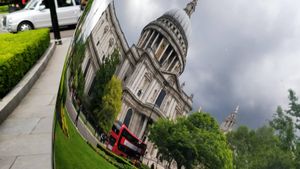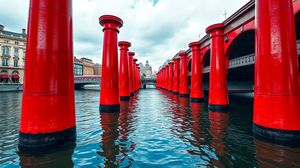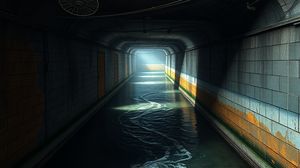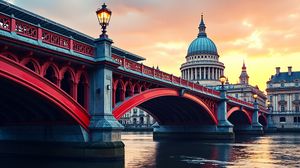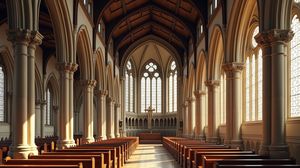
The Millennium Bridge, also known as the London Millennium Footbridge, is a striking pedestrian suspension bridge that spans the River Thames. This modern marvel connects the energetic cultural hub of Bankside with the historic area around St. Paul's Cathedral. Designed by the renowned architecture firm Foster and Partners, in collaboration with sculptor Anthony Caro and engineering firm Arup, the bridge is celebrated for its sleek and minimalist design.
Opened in June 2000, the bridge initially faced a notable engineering challenge. Upon its inauguration, the world watched as it wobbled under the foot traffic of excited Londoners. This was due to an unexpected lateral vibrational movement known as synchronous lateral excitation, prompting its temporary closure just two days later. Ingenious engineers quickly solved the problem using "dampers," reopening the bridge in 2002 without the wobble, earning it the playful nickname "Wobbly Bridge" in local lore.
The Millennium Bridge offers a dramatic panoramic view of the London skyline, with St. Paul's Cathedral's majestic dome framed perfectly on one side. On the opposite end, visitors can walk straight into Tate Modern, one of the world's most visited modern art galleries. This unique architectural and cultural juxtaposition exemplifies the seamless blend of history and modernity in London.
Movie buffs might recognize the Millennium Bridge from its memorable appearance in the 2009 film "Harry Potter and the Half-Blood Prince," where it met a cinematic demise at the hands of Death Eaters. This has made the bridge a popular spot for fans of the franchise, eager to walk in the footsteps of their favorite wizards.
In addition to its cinematic fame, the bridge has been a site for numerous public art installations. These have included soundscapes and light shows, making it not just a means of crossing the river, but an ever-changing exhibition space embracing London's vibrant artistic spirit.
The Millennium Bridge is also a feat of sustainable engineering. Its design intentionally minimizes its environmental impact on the Thames, with energy-efficient lighting a small but significant contribution to London's efforts in reducing its carbon footprint.

Making the Most of Your Visit:
Start your journey on the St. Paul's side of the bridge for the most impressive visual lineup. The sight of St. Paul's Cathedral gradually towering behind you as you walk towards the River Thames makes for dramatic photography, especially in the early morning light or at sunset.
If you're a fan of Harry Potter, enjoy recreating the scenes from “Harry Potter and the Half-Blood Prince.” Stand where the infamous collapse scene was filmed, and capture some magic to share with fellow fans. It's a great conversation starter!
Keep an ear out for impromptu performances or temporary art installations as you stroll across. The bridge has been home to various soundscapes and exhibitions that often surprise and delight visitors. There's always the chance to experience something unique just by being there.
Try to visit during off-peak hours for a more leisurely experience, as it can get quite busy at peak times. Late mornings or early evenings on weekdays often offer a more serene walk, with clearer views of London without the bustling crowd.
For a unique perspective, head below the bridge to the Thames Path. The view looking up at the bridge's sleek, minimalist design against the backdrop of the cityscape is magnificent and makes for a less common but equally impressive photo opportunity.

Visiting Times & Costs:
The Millennium Bridge is a pedestrian bridge and is open to the public 24 hours a day, 7 days a week, all year round. It provides a convenient and scenic route across the River Thames.
There is no cost to cross the Millennium Bridge; it is free for all visitors.
The bridge is generally accessible to people with disabilities. The pathways and bridge surfaces are smooth, allowing for wheelchair access and accommodating those with mobility impairments.

Address & Map:

Nearby:










